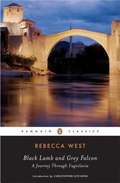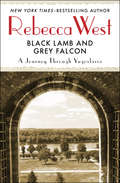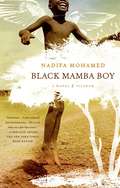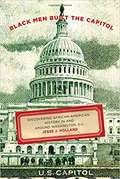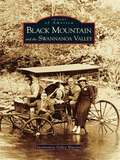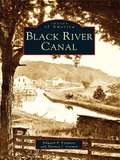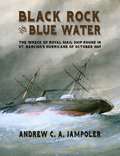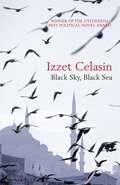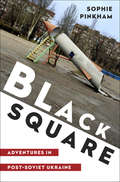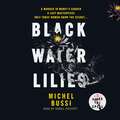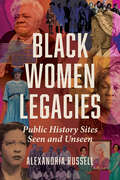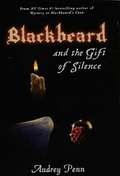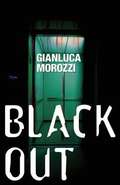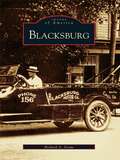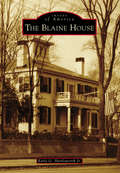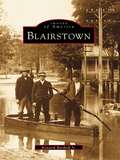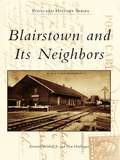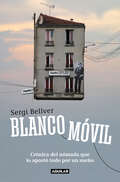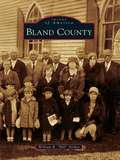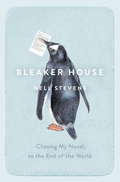- Table View
- List View
Black Lamb and Grey Falcon: A Journey Through Yugoslavia (Canongate Classics Ser.)
by Christopher Hitchens Rebecca WestWritten on the brink of World War II, Rebecca West's classic examination of the history, people, and politics of Yugoslavia illuminates a region that is still a focus of international concern. A magnificent blend of travel journal, cultural commentary, and historical insight, Black Lamb and Grey Falcon probes the troubled history of the Balkans and the uneasy relationships among its ethnic groups. The landscape and the people of Yugoslavia are brilliantly observed as West untangles the tensions that rule the country's history as well as its daily life.
Black Lamb and Grey Falcon: A Journey Through Yugoslavia (Canons Ser.)
by Rebecca WestHailed as among the most important books of the twentieth century, Rebecca West&’s magnum opus is a history, a travelogue, and a sociological study of Yugoslavia that examines how the past shapes the present In a breathtakingly wide-ranging journalistic work, West richly chronicles her travels throughout Yugoslavia in the 1930s, introducing vivid characters and illuminating details. More than a travelogue, Black Lamb and Grey Falcon connects the people and places West encounters to the long history of conflict that has formed national identities in the Balkans across a millennium of shifting alliances. West writes, &“I had come to Yugoslavia because I knew that the past has made the present, and I wanted to see how the process works.&” As profound, sad, and funny as when it was first published in 1941, Black Lamb and Grey Falcon interrogates the forces that continue to shape our modern world.
Black Mamba Boy
by Nadifa MohamedYemen, 1935. Jama is a "market boy," a half-feral child scavenging with his friends in the dusty streets of a great seaport. For Jama, life is a thrilling carnival, at least when he can fill his belly. When his mother--alternately raging and loving--dies young, she leaves him only an amulet stuffed with one hundred rupees. Jama decides to spend her life's meager savings on a search for his never-seen father; the rumors that travel along clan lines report that he is a driver for the British somewhere in the north. So begins Jama's extraordinary journey. His travels in search of his father, and later in search of work to support his new wife, take more than a thousand miles north, all the way to Egypt, by camel, by truck, by train, but mostly on foot. He slings himself from one perilous city to another, fiercely enjoying life on the road and relying on his vast clan network to shelter him and point the way to his destiny. In his travels, Jama will witness scenes of great humanity and brutality; he will be caught up in the indifferent, grinding machine of war; he will crisscross the Red Sea in search of working papers and a ship. Bursting with life and a rough joyfulness, Black Mamba Boy is debut novelist Nadifa Mohamed's vibrant, moving celebration of her family's own history.
Black Men Built the Capitol: Discovering African-American History In and Around Washington, D. C.
by Jesse Holland*Slaves built the Capitol, White House, and other important Washington structures *The National Mall sits on the site of the city's once-bustling slave market *The grounds that are now Arlington National Cemetery were once a self-sustaining village for former slaves <P><P> Millions of people visit the National Mall, the White House, and the U.S. Capitol each year. If they only hear the standard story, a big question remains: Where's the black history? Packed with new information and archival photos, Black Men Built the Capitol answers this question.
Black Mountain and the Swannanoa Valley
by Swannanoa Valley MuseumNorth Carolina's magnificent Blue Ridge Mountains have drawn people to the Swannanoa Valley since the beginning of time. Rivers and forests lured early hunters and gatherers; later inhabitants tilled the rich, fertile soil and logged the thick forests on the mountainsides. People also came to the mountains to enjoy the mystical beauty and enchantment of the area, the cool, crisp climate, and the sparkling waters of brooks and streams. Hiking, camping, and the tranquility of a woodland world provided escape from city life. The Swannanoa Valley is cradled between the Craggy Mountains to the north and the Swannanoa Mountains to the south. Mount Mitchell, the highest peak in America east of the Mississippi River, rises majestically nearby. Among the early visitors who decided to settle in the valley were those who purchased the land that later became the sites of the famous conference centers in the area-Montreat, YMCA Blue Ridge Assembly, and Ridgecrest-and businessmen, who brought industry to the area.
Black River Canal (Images of America)
by Edward P. Fynmore Harney J. CorwinBlack River Canal documents in images how a manmade river transformed a region. This upper New York State canal was an improbable engineering success. In 1825, DeWitt Clinton proposed construction of a canal that would link the Erie Canal at Rome with the Black River at Lyons Falls. The idea was well received, but the obstacles were great. The canal would have to run uphill. In the end, the 35-mile overland canal required a record 109 locks to negotiate a rise and fall of 1,079 feet. Construction was authorized in 1836, and against all odds, the Black River Canal was fully operational in 1855. The canal brought a measure of prosperity to an isolated region of the state and promoted development of a wood products industry that continues to this day.
Black Rock and Blue Water
by Andrew C. JampolerRMS Rhone, just three years old then and the pretty queen of the Royal Mail Steam Packet Company's fleet, sank in the great St. Narciso hurricane of late October 1867, a devastating category three storm that bored a line east to west atop the Antilles, and ruthlessly thinned the islands' population while it sank some seventy ships in port and local waters.Fleeing from Tortola across Drake Strait and toward open water at full speed, through the backside of the hurricane and nearly blinded by rain and spray, Rhone drove aground on Black Rock, in the shallows off Salt Island, shoved to her fate by 140 mile and hour winds. The impact and the subsequent explosion of her boiler tore the 310-foot long ship in half. One hundred twenty four drowned that morning or were scalded to death in the engine room. Only twenty-three survived.Five other company ships went down, too. Remarkably, a sixth company ship, the tiny paddle steamer Conway managed to live through the day, although dismasted and with her deck swept clear of funnel, paddle boxes, and rigging.This is the story of those ships, and the story of Jeremiah Murphy, a salty hardhat diver, who spent most of the next six years salvaging the wreck of the Rhone and clearing neighboring harbors of the storm's detritus. Without a doubt, Black Rock and Blue Water will appeal powerfully to readers of maritime history, and to recreational divers of all ages.
Black Sky, Black Sea
by Izzet Celasin1977. Poised between the secular values of socialism and the conservatism of a tenuously balanced government, Istanbul is a fractured city haunted by demons of its own making. Along with thousands of other left-wing activists, Oak's interest in politics leads him to join the annual May Day rallies. There he encounters Zuhal, a fearless girl with a gun. As battles rage between nationalists and socialists, Oak witnesses the violent suppression of dissident minorities by his fellow citizens. The bewitching Zuhal begins to shape his ideals, bringing him face to face with disillusionment, and death.
Black Sky, Black Sea
by Izzet Celasin1977. Poised between the secular values of socialism and the conservatism of a tenuously balanced government, Istanbul is a fractured city haunted by demons of its own making. Along with thousands of other left-wing activists, Oak's interest in politics leads him to join the annual May Day rallies. There he encounters Zuhal, a fearless girl with a gun. As battles rage between nationalists and socialists, Oak witnesses the violent suppression of dissident minorities by his fellow citizens. The bewitching Zuhal begins to shape his ideals, bringing him face to face with disillusionment, and death.
Black Square: Adventures in Post-Soviet Ukraine
by Sophie PinkhamA distinctive writer’s fascinating journey into the heart of a troubled region. Ukraine has rebuilt itself over and over again in the last century, plagued by the same conflicts: corruption, poverty, substance abuse, ethnic clashes, and Russian aggression. Sophie Pinkham saw all this and more in the course of ten years working, traveling, and reporting in Ukraine and Russia, over a period that included the Maidan revolution of 2013–14, Russia’s annexation of Crimea, and the ensuing war in eastern Ukraine. With a keen eye for the dark absurdities of post-Soviet society, Pinkham presents a dynamic account of contemporary Ukrainian life. She meets—among others—a charismatic doctor helping to smooth the transition to democracy even as he struggles with his own drug addiction, a Bolano-esque art gallerist prone to public nudity, and a Russian Jewish clarinetist agitating for Ukrainian liberation. These fascinating personalities, rendered in a bold, original style, deliver an indelible impression of a country on the brink. Black Square is necessary reading for anyone who wishes to learn not only the political roots of the current conflict in Ukraine but also the personal stories of the people who live it every day.
Black Water Lilies: 'A dazzling, unexpected and haunting masterpiece' Daily Mail
by Michel BussiTHE INTERNATIONAL BESTSELLER 'Ends with one of the most reverberating shocks in modern crime fiction' The Sunday Times 'A dazzling, unexpected and haunting masterpiece' Daily Mail 'A work of genius... Stunning' Daily Express Jérôme Morval has been found dead in the stream that runs through the gardens at Giverny, where Monet did his famous paintings. In Jérôme's pocket is a postcard of Monet's 'Water Lilies' with the words: Eleven years old. Happy Birthday.Entangled in the mystery are three women: a young painting prodigy, the seductive village schoolteacher and an old widow who watches over the village from a mill by the stream. All three of them share a secret. But what do they know about Jérôme's death? And what is the connection to the mysterious 'Black Water Lilies', a rumoured masterpiece by Monet that has never been found?MICHEL BUSSI: THE MASTER OF THE KILLER TWIST ''A novel so extraordinary that it reminded me of reading Stieg Larsson for the very first time' The Sunday Times on After the Crash'Inventive, original and incredibly entertaining' Sunday Mirror on Don't Let Go 'Combines an extraordinarily inventive plot with characters haunted by long-ago events - and demonstrates why he has such a hold on readers' The Times on Time Is A Killer
Black Water Lilies: 'A dazzling, unexpected and haunting masterpiece' Daily Mail
by Michel BussiGiverny. During the day, tourists flock to the former home of the famous artist Claude Monet and the gardens where he painted his Water Lilies. But when silence returns, there is a darker side to the peaceful French village.This is the story of thirteen days that begin with one murder and end with another. Jérôme Morval, a man whose passion for art was matched only by his passion for women, has been found dead in the stream that runs through the gardens. In his pocket is a postcard of Monet's Water Lilies with the words: Eleven years old. Happy Birthday.Entangled in the mystery are three women: a young painting prodigy, the seductive schoolteacher and an old widow who watches over the village from a mill by the stream. All three of them share a secret. But what do they know about the discovery of Jérôme Morval's corpse? And what is the connection to the mysterious, rumoured painting of Black Water Lilies?(p) 2016 Orion Publishing Group
Black Women Legacies: Public History Sites Seen and Unseen (Women, Gender, and Sexuality in American History)
by Alexandria RussellFrom Black clubwomen to members of preservation organizations, African American women have made commemoration a central part of Black life and culture. Alexandria Russell illuminates the process of memorialization while placing African American women at the center of memorials they brought into being and others constructed in their honor. Their often undocumented and unheralded work reveals the importance of the memorializers and public memory crafters in establishing a culture of recognition. Forced to strategize with limited resources, the women operated with a resourcefulness and savvy that had to meet challenges raised by racism, gender and class discrimination, and specific regional difficulties. Yet their efforts from the 1890s to the 2020s shaped and honed practices that became indispensable to the everyday life and culture of Black Americans. Intersectional and original, Black Women Legacies explores the memorialization of African American women and its distinctive impact on physical and cultural landscapes throughout the United States.
Blackbeard and the Gift of Silence
by Audrey PennWhen the four young teens from Okracoke Island, North Carolina, travel to England to return pirate loot stolen from Westminster Abbey in 1718, they learn of far deeper mysteries concerning the Stone of Scone and Blackbeard the pirate.
Blackbeard and the Sandstone Pillar: When Lightning Strikes
by Audrey PennIn this leg of an adventure, the kids follow the trail of the loot under hot pursuit, a trail that leads halfway around the world and to the bottom of the Atlantic Ocean.
Blackout
by Howard Curtis Gianluca Morozzi"A spine-tingling novel that keeps you mesmerized from beginning to end."--InfiniteStorie"Morozzi has a light touch. He has an uncanny ability to convey mood swings, excitement and plot twists with ever increasing velocity."--Gazzetta di Parma"A chilling and claustrophobic thriller with an unpredictable ending. Morozzi joins the best in the genre."--LINUSBologna in August: unbearable heat, an empty city. Claudia is a young student in a hurry to return home from her work as a waitress and get out of the skimpy uniform she hates. Tomas is a young man on his way to elope to Amsterdam with his girlfriend, Francesca. Aldo is a husband and father with an uncanny resemblance to Elvis Presley, anxious to get to an apartment filled with guilty secrets. All three have an urgent need to be somewhere else. Instead, they are trapped in an elevator in a deserted building on a holiday weekend. They are like three wasps in an upturned glass . . . and one of the trio is a serial killer.This dark, twist-packed psychological thriller in the style of Phonebooth has been adapted as a US film to be released in the fall of 2008, starring Amber Tamblyn and directed by cult Mexican auteur Rigoberto Castañeda.Gianluca Morozzi was born in Bologna in 1971, where he lives today. He is well-known as a cutting-edge satirist and music critic, often compared to Nick Hornby and Ben Elton. Blackout is his first thriller.
Blacksburg (Images of America)
by Richard A. StrawIn 1798 William Black set aside 38 acres of land in an area known as Draper's Meadow to establish the village that would take his name: Blacksburg, Virginia. In the more than 200 years since its founding, this once small frontier outpost has grown into what the Washington Post recently called "the most wired city in America." A diverse and well-educated community, Blacksburg holds a special place in the hearts of its residents as well as Virginia Tech students and alumni. From its humble beginnings in the late 18th century Blacksburg has evolved into a vibrant, diverse, and progressive community of nearly 40,000. Today Blacksburg sits on the cutting edge of great historical, environmental, cultural, and scientific frontiers, just as it did over 200 years ago.Photos in the book reveal the architectural and physical evolution of a vibrant Main Street, which was and still is the very heart of the town. After 1872 town life began to interact with that of the new state university placed in Blacksburg; this study includes many engaging images of life at Virginia Tech over the years. Fascinating photos of people, places, homes, businesses, and important events in the town's history complete the collection. In this contribution to the Images of America series Straw has provided us with an informative look into an earlier period of life in this most interesting and appealing community.
Blaine House, The (Images of America)
by Earle G. Shettleworth Jr.The Blaine House in Augusta is one of Maine's most notable homes. In 1862, three decades after the house was built by Capt. James Hall in the early 1830s, James and Harriet Blaine moved in. The home became the setting for one of the most meteoric careers in American politics, during which James Blaine served as Speaker of the US House of Representatives, US senator, secretary of state, and Republican candidate for president in 1884. After the deaths of her parents, the Blaines' daughter Harriet Blaine Beale gave the house to the state in 1919. Since 1920, it has served as the official residence of the state's governors and their families. As a symbol of state government, it ranks with the Maine State House. The house has been a National Historic Landmark since 1964. Architecturally, it reflects a combination of Federal, Victorian, and Colonial Revival styles. Today, the Blaine House functions as a social showcase for Maine, a working office, and family living quarters.
Blairstown
by Kenneth Bertholf Jr.Blairstown, New Jersey lies along the summit of the Blue Mountains, and from that point down to the Valley of the Paulinskill is a succession of hills and valleys. Tammany, Chief of the Delaware, calledthis area "Touockonetcoug," which means "Gem of the Paulinskill." The beautiful forests, streams, and mountains of this area make it the perfect subject for an engaging pictorial history. Images in this book include those of the first families to settle in the area, including the Blairs and the Howells. The town was named for the Honorable John I. Blair, one of its earliest prominent citizens, and was formed from a part of Knowlton Township by an act of the State Legislature in February 1845. In this collection discover Blairstown as it once was, prior to the many changes that were made in the name of progress. View original homesteads, businesses, and schools in the community, and learn about the residents who shaped its future. Photographs and postcards depicting the construction and completionof railroad lines are shown, along with images of recreational retreats such as Silver Lake and Cedar Lake. Photographs of surrounding communities, including Delaware, Columbia, Hainesburg, Vail, Hope,Johnsonburg, and Centerville are also included in this collection.
Blairstown and Its Neighbors
by Kenneth Bertholf Jr. Don DorflingerTucked beside the Kittatinny Mountains in the beautiful valley of the Paulinskill River, Blairstown combines the charm of an 1800s agrarian village with many amenities of a 21st-century community. Named for its most famous resident, noted American industrialist and railroad builder John Insley Blair, it was incorporated in 1845. Known for the college preparatory academy that bears Blair's name, the heritage and history of this community has long been appreciated by its residents. Through vintage postcards from their own collections and supplementary material, the authors invite you to step back in time to visit Blairstown and the neighboring villages of Hope, Hardwick, Johnsonburg, and Marksboro in an era when the horse and buggy took you to local destinations and the railroad was your passport to the larger world.
Blanchester (Images of America)
by Richard Read Robyn Stone-KraftJohn and Joseph Blancett laid out the village of Blanchester in 1823. The community started as a central collection of log buildings among miles of farmland. Since that time, the village has grown, flourished, and suffered. The fire of 1895 destroyed most of the main commercial district at the heart of the village. Sons were sent off to fight in the Civil War and both World Wars. Through it all, Blanchester grew and thrived, and the community celebrated its centennial in 1924--a year late. Today, Blanchester is still a tightly knit village, where friends greet each other as they walk down the street and community events are put on a yearly schedule.
Blanco móvil: Crónica del nómada que lo apostó todo por un sueño
by Sergi BellverEl relato de un hombre nómada que vive de manera itinerante desde hace más de una década. Una historia acerca de perseguir tu pasión al margen de las convenciones. Sergi Bellver es escritor y no tiene casa, aunque tampoco vive en la calle. Hace ya más de una década -primero empujado por la necesidad, pero pronto convencido de su elección-, comenzó a habitar en viviendas prestadas. Desde pisos vacíos en barrios obreros a verdaderas mansiones, o de humildes cabañas a los lugares más insólitos, su singular viaje a lo largo de los años nos muestra otros caminos posibles y nos anima a no renunciar a nuestros sueños ante las dificultades. Y es que esta crónica apasionada y reflexiva de una asombrosa vida nómada es, sobre todo, una historia acerca de la libertad personal y creativa, una mirada crítica a los oficios de la cultura y un alegato a favor del arte como fuerza transformadora de la realidad. «Desde aquel primer sofá prestado, he dormido en sitios que van de lo precario a lo opulento y de lo onírico a lo insólito. (...) no siempre he sido más feliz, ni he estado más a gusto, ni he podido escribir mejor en los lugares a priori más atractivos de ese peculiar listado, sino en aquellos en los que sentí haber encontrado de veras un refugio». «[...] la belleza y la maravilla no nos necesitan para suceder cada día. Lo único que podemos hacer todos, artistas o no, es permanecer atentos y seguir dispuestos a percibirlas. La próxima vez que te conectes a la red, recuerda que tu descarga viaja a toda velocidad por enormes cables submarinos de fibra óptica, pero también que justo encima de ellos, en la profundidad del océano, los cachalotes siguen cazando calamares gigantes o migran todavía algunas ballenas que ya estaban vivas el año que Herman Melville publicó Moby Dick. Y cuando un petirrojo venga a darte los buenos días, las gaviotas armen su escándalo en la playa o, al caer el sol, los mirlos te alegren la tarde con su conversación, piensa que los dinosaurios no desaparecieron, sino que aprendieron a estar en el mundo de otra manera. Una bastante hermosa, además, tan diversa como las moradas de un nómada y tan ligera como su equipaje». Reseñas:«Blanco móvil es la bella, divertida, ácida y emocionante crónica de un nómada que escribe, ama y acampa en los libros. Leed y disfrutad».Carlos Bardem «Sergi Bellver afronta la vida como la escritura: como un acto de resistencia ante el curso de los tiempos. En este libro, vida y escritura son la misma cosa».Juan Soto Ivars
Bland County
by William R. ArcherBland County is one of the smallest counties of the Old Dominion, yet it is filled with spectacular, unspoiled, scenic vistas that rival any rural area on the North American continent. Bland County is a tree-covered paradise with no incorporated towns, and about one-third of the county's 369 square miles are included in the Jefferson National Forest. The history of Bland County after the arrival of European settlers includes stories of patriotism, independence, as well as struggles against incredible odds. The Virginia General Assembly formed Bland County on March 30, 1861. The county has always been for progress, with lumber companies arriving in the late 19th century to harvest the county's vast timber resources and the railroad following at the start of the 20th century. Bland County was also home to a huge Civilian Conservation Corps camp in the 1930s. From communities like Ceres to No Business and Hicksville to Bland, the entire county has a great story to tell.
Blasted Heaths and Blessed Green: A Golfer’s Pilgrimage to the Courses of Scotland
by James W. FineganEvery golfer alive knows that he or she has two ancestral homes: one's own, and Scotland. On her rolling shores the game of golf had its origins, and to walk the links of St. Andrews is to feel at one with the shepherd who decided one day to see how far he could whack a stone with his crook. Most serious golfers will make the pilgrimage to Scotland, to try to hit the Postage Stamp green at Troon, to trace the footsteps of Ben Hogan at Carnoustie, and to brave the challenge of the Road Hole at St. Andrews; all golfers dream of taking such a trip.For the tourist or the dreamer, there can be no better guide than James W. Finegan. A passionate advocate of the game that's played on the links between land and sea, Finegan combines a writer's eye, a historian's knowledge, and a golfer's sense of wonder and apprehension to provide an impossibly ambitious grand tour of golf's native land.In a loop of a thousand miles that begins in Edinburgh and ends across the Firth of Forth in St. Andrews, Finegan covers some sixty courses, visiting the true shrines of the game, the courses that are well known and respected, and the little-known gems you might otherwise pass right by. He shares the history of the courses, both of their creation and of the most famous matches played there; he also writes marvelously about the scenic and strategic charms to be found as you play them yourself. And he provides all the information you need to make your arrangements to do just that -- because, unlike most championship courses in the United States, the great courses of Scotland are available to the public.In addition to his delightful descriptions of the golf to be found there, Finegan gives us his recommendations for places to stay, ranging from the most modest bed-and-breakfast to the most magnificent castle hotel. He describes the pleasures to be found off the beaten track: the spectacular views from a country road, or the ancient cathedral that's worth a stop on the way to the first tee. And because all the travel within the country is done by car, he spells out the actual routes from town to town and course to course.Blasted Heaths and Blessed Greens is a book to be read, to be savored, and to be tucked away in your suitcase when you finally undertake the journey of your dreams.
Bleaker House: Chasing My Novel to the End of the World
by Nell StevensOn a frozen island in the Falklands, with only penguins for company, a young would-be writer struggles to craft a debut novel...and instead writes a funny, clever, moving memoir that heralds the arrival of a fresh new literary talent.Twenty-seven-year-old Nell Stevens was determined to write a novel, but somehow life kept getting in the way. Then came an irresistible opportunity: she won a fellowship to spend three months, all expenses paid, anywhere in the world to research and write a book. Did she choose a glittering metropolis, a romantic village, an exotic paradise? Um, no. Nell chose Bleaker Island, a snowy, windswept pile of rock off the Falklands. There, in a guesthouse where she would be the only guest, she imagined she could finally rid herself of distractions and write her 2,500 words a day. In three months, surely she'd have a novel, right? It's true that there aren't many distractions on Bleaker, other than sheep, penguins, paranoia and the weather. But as Nell gets to work on her novel--a delightful Dickensian fiction she calls Bleaker House--she discovers that an excruciatingly erratic Internet connection and 1100 calories a day (as much food as she could carry in her suitcase, budgeted to the raisin) are far from ideal conditions for literary production. With deft humour, this memoir traces Nell's island days and slowly reveals details of the life and people she has left behind in pursuit of her art. They pop up in her novel, as well, as memoir and novel start to reflect one another. It seems that there is nowhere Nell can run--neither a remote island nor the pages of her notebook--to escape herself. A whimsical, entertaining, thought-provoking blend of memoir and travelogue, laced with tongue-in-cheek writing advice, Bleaker House brilliantly captures the hopes, fears, self-torture and humour of being young and yearning to make a creative life. With winning honesty and wit, Nell's race to finish her book emerges as a fascinating narrative in its own right.
